Russian-made surveillance technologies being used in the West

A longer version of this article was previously published in Wired on 10 May 2013.
We all know surveillance is big in Putin’s Russia. What you may not know is that Russia’s surveillance tech is being used all over the world, even in the U.S.
The Kremlin is up to its domes in spy technology. One reason is fear, provoked by the Arab Spring, of a growing and diffuse protest movement that uses social media to organize. Notably, the authorities have taken an interest in DPI (deep packet inspection) tools, which are essential to monitoring the internet Russia-wide. The largest voice-recognition company in Russia, has likewise developed close ties with the authorities.
Russia is not exactly a newcomer. The Soviet Union worked heavily on a litany of tools to spy on its own citizens. But for years, internet monitoring in Russia was carried out on the regional level: a hodge-podge of systems that blocked banned websites, as ordered by regional courts. That changed in November, when the Kremlin moved to implement a nation-wide internet-filtering system to block websites deemed extremist and harmful to children — a label often painted with a broad brush to mean anyone who opposes the Putin regime.
It’s also not just Russia that’s buying Russian-made surveillance technologies. Russian technologies can now be found in former Soviet republics, as well as very far from Moscow: in Latin America, Canada and even the United States.
Voice Recognition
The world leader in voice recognition technology goes by two names. In the company’s home city of Saint Petersburg, it’s known as the Speech Technology Center, or STC. In the United States, it operates from its New York City offices under the name SpeechPro. The anodyne names betray no signs that the company’s origins trace to a secret Soviet technologies unit run under the auspices of the KGB — and developed inside the Stalin-era Gulag system of convict labor camps.
In 2010, the STC completed its first national voice recognition project — surprisingly not in Russia — but in Mexico. The system is able to use state records of human voice and biometric details to identify individuals from fragments of speech alone. Mexico’s national database includes recorded speech fragments from criminals, law enforcement personnel and many law-abiding citizens, who are obliged to supply vocal samples for state-regulated activities such as obtaining a driver’s license. A huge database was built containing up to several million voices of known criminals, persons of interest, or people on a watch list. It takes just five seconds to scan through 10,000 voices, and its accuracy, STC claims, is at least 90 percent.
Most recently, the company has sought to strengthen its ties to the Kremlin and find new markets for its biometric tools. In 2011, Russia’s state-affiliated Gazprombank became the joint owner of STC. Gazprombank, to clarify, is part of the vast business empire of Yuri Kovalchuk, a close friend of Vladimir Putin.
Face Spotting
STC does not limit itself to voice recognition, but is involved in developing face recognition technologies as well. In December 2012, STC announced it had gone to Ecuador and installed “the world’s first biometric identification platform, at a nation-wide level, that combines voice and face identification capabilities.”
The system allows authorities to accumulate a large image database of criminals and suspects. STC also claims it has invented algorithms that “deliver reliable results even when facial characteristics have undergone physical changes, and the system’s voice and face modalities can be used together or separately — a voice sample or facial image alone is sufficient to make an identification.” Publicly, STC is cautious to note that its surveillance technologies are used for only good, but as STC has also sold technology to authoritarian regimes in Uzbekistan and Belarus, among others.
Data Grabbing
When it comes to lawfully intercepting private communications, the standards and procedures are different in the United States than they are in Russia, as we wrote in December. Some Russian manufacturers, however, have still found a way to penetrate into the North American market.
One of them is MFI-Soft. The company’s focus: a vendor of information security and telecommunications “solutions” for law enforcement agencies, VoIP (or voice over internet protocol) carriers and internet service providers. And the company claims to develop products for law enforcement, national security and intelligence agencies, and the military.
In Canada, the company is known under the name ALOE Systems, based in the Toronto suburb of Markham. ALOE’s leading interception technology, NetBeholder, provides a high-end system capable of detection, monitoring, storage and analysis of information traveling over the internet, and a laptop system “designed specifically for field interception — at Internet cafes, hotels, restaurants and other public places.”
Beyond Canada, ALOE’s list of clients consists of telecom operators in the United States and Mexico, along with Argentina, Brazil, Costa Rica, El Salvador, Peru and Uruguay. Vitaly Potapov, an ALOE senior sales manager whom we met at the company’s office in Markham, explained that the company plans to open a U.S. office within a few months: “The market for our VoIP technologies is huge in the States,” he said.
Mobile Phone Interception
The traditional way to eavesdrop on phone calls is to monitor the telecom operator for incoming calls. When dealing with mobile phones, however, it can be much more effective to intercept calls right on the spot.
Discovery Telecom Technologies (DTT) has exactly that kind of equipment. The company’s AIBIS system (or In-Between Interception System) works by masquerading as a cell phone tower, sucking in nearby signals and allowing the device’s operator to superstitiously listen and record. Established in Moscow, the firm also counts offices in Switzerland and Salt Lake City, Utah, and boasts on its Russian website about including the Kremlin and the FSB among its clients.
“This product does actual interception of cell phone communications content,” Christopher Soghoian, the American Civil Liberties Union’s top technologist, tells Danger Room. According to a product description, AIBIS is able to intercept up to eight incoming and outgoing mobile phone calls “with any type of encryption, in real-time.” It can also “work with moving and driving targets, providing fast, reliable interception, interrogation, data analysis, IMSI/IMEI catching and selective jamming of GSM traffic in the area.”
That also extends to general packet radio service (or GPRS) traffic, which means SMS messages and mobile internet access can be monitored. The system can selectively jam cell phone signals, and it also includes a module to help locate targets. The whole package weighs around 22 pounds.



